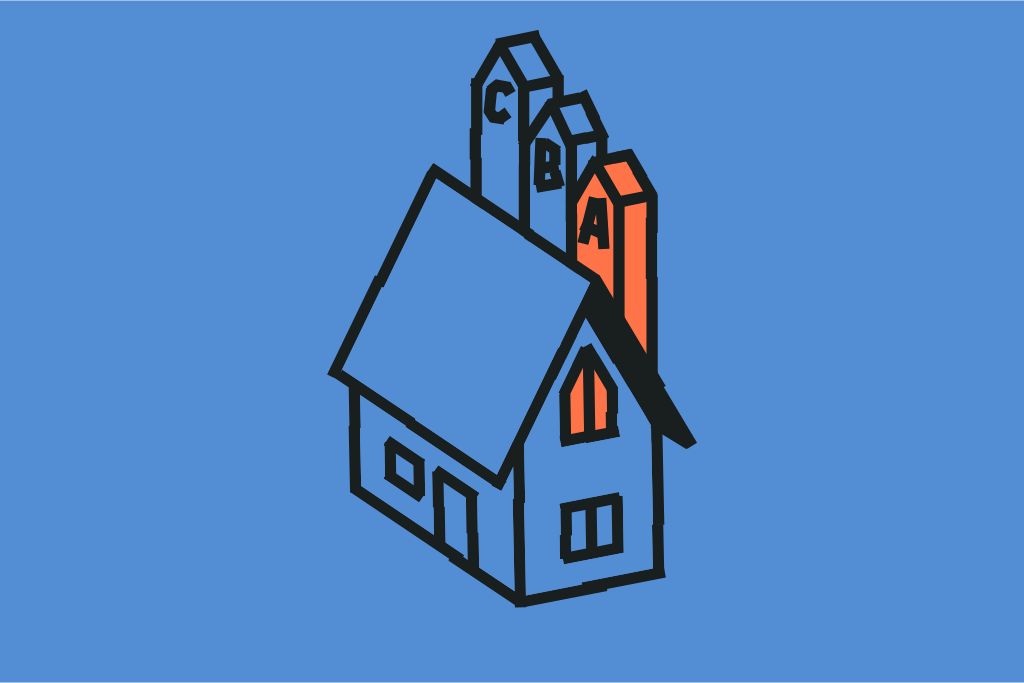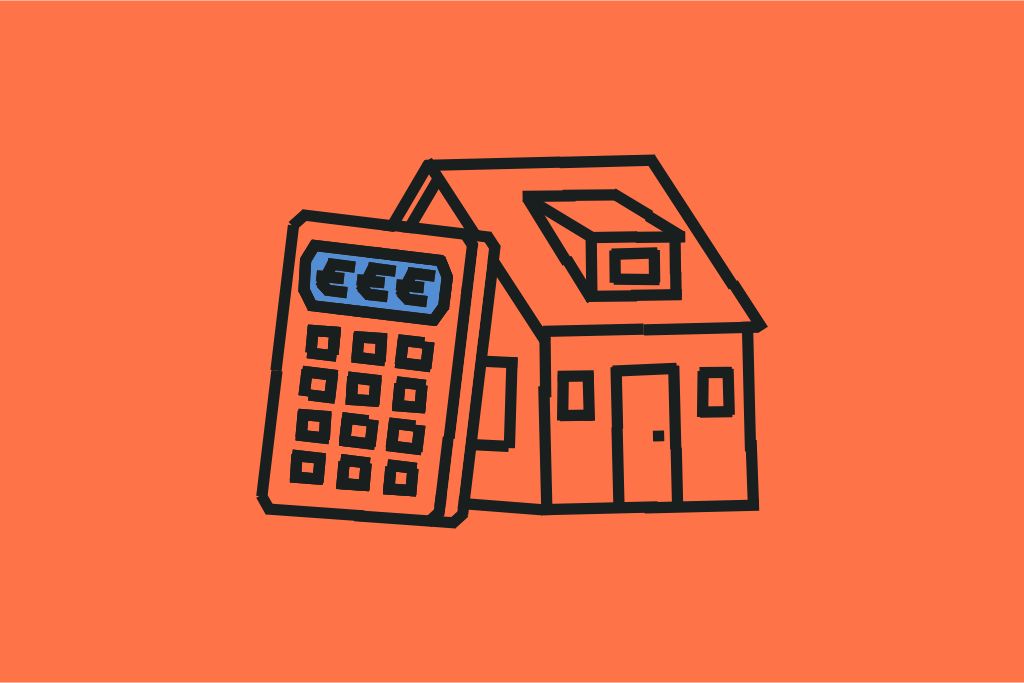What is energy label D?
Energy label D means that your home has average energy consumption. A house with label D uses 250-290 kWh per m² per year. This puts this label in the middle of the scale from A to G.
A house with energy label D is often poorly insulated. There is sometimes double-glazing, but also single-glazing. Heating is usually via a standard central heating boiler, and sustainable installations such as a heat pump or solar panels are often missing.
This means higher energy costs, less comfort and often a lower market value than a comparable home with a higher energy label.
Want to know what label your home has? Easily request a new energy label.
{{cta}}
When do you have energy label D?
A house receives energy label D when its energy consumption is between 250 and 290 kWh per m² per year. This is the main condition for obtaining this label.
Characteristics of a house with energy label D
- Property is moderately insulated, e.g. only roof insulation.
- Often still double-glazed or even single-glazed, instead of HR glass.
- Heating with a central heating boiler, sometimes old or outdated.
- Hardly any or no solar panels present.
- Relatively high consumption relative to C, but lower than E.
So a home labeled D is on average energy efficient, but there is still plenty of room for improvement.
Want to know exactly what energy labels are and how they differ? Then read our article energy labels A to G.

Advantages and disadvantages of energy label D
Energy label D means that your home uses average energy. The advantage is that your house is often cheaper to buy and that you can quickly add value by making it more sustainable. The disadvantage: you have higher energy costs, less comfort and less favorable mortgage terms.
Advantages of energy label D
- Lower purchase price: often cheaper than homes with a green energy label.
- Value increase possible: with energy-saving measures, your home can quickly rise to an improved energy label.
Disadvantages of energy label D
- Monthly energy costs relatively high: your energy bill is significantly higher than with label C or A.
- Lower living comfort: moderate insulation causes drafts, cold and heat loss.
- Lower home value: the same home with a higher energy label is worth more.
- Less favorable mortgage terms: you don't get extra borrowing room and banks are often stricter with lower labels.
{{cta}}
Energy costs of a house with energy label D
A home with energy label D costs on average €9180 per year in energy, which amounts to about €765 per month for a single-family home of 120 m².
This is based on an average consumption of 250-290 kWh per m² per year and the current electricity price of €0.27 per kWh in September 2025, according to ANWB. In practice, energy costs may vary. This depends on factors such as insulation, the number of occupants, the type of home and energy use.
Want to know how your home scores and if you can get a better label? Easily request a new energy label.

How do you improve energy label D?
You can improve energy label D by investing in insulation, glass replacement, a new heating system and solar panels. In doing so, you reduce your energy consumption and grow your home to a higher label, such as C or B.
The main areas for improvement are:
- Replacing single glass with HR++ or triple glass (e.g. in cavity walls)
- Insulate roof, floor and walls for less heat loss.
- Replace boiler with hybrid or full heat pump.
- Installing solar panels to generate your own power.
- Smart applications such as thermostats and energy-efficient appliances.
When you have made these improvements, you significantly reduce your energy consumption. Your home will rise to a higher energy rating, which is good for your wallet and for a better climate.

What does energy label D mean for your mortgage?
Energy label D means that you get €5000 extra borrowing space with your mortgage.
- For a home with energy label A or B, you may borrow up to €20,000 extra.
- For energy label E, F or G, you may also borrow an additional €20,000, but that amount must be compulsorily invested in sustainability.
- With a home with energy label D, these benefits do not apply.
On top of that, banks often have stricter terms and conditions. That can mean less maximum loan amount or a higher interest rate compared to a home with a green energy label.

Frequently asked questions about energy label D
Do you still have questions after reading this article? You're not the only one. Below you will find answers to the most frequently asked questions about energy label D. So you know exactly what this label means, how you can improve your home and what the consequences are for your costs and mortgage.
Is energy label D good?
Energy label D falls in the middle class and is not considered a good label. Energy consumption is 250-290 kWh per m² per year, which is higher than for a house with a relatively low consumption such as label C or label A. The house itself is often built with limited insulation, so central heating pipes and walls lose heat. This makes the home less energy efficient than most homes with a higher label.
What is the difference between energy label C and D?
The difference between energy label C and D is in how much energy a home consumes. Label C means 190-250 kWh per m² per year, while a house with label D uses 250-290 kWh per m². This means you pay more and less heat is lost with label C. A home with label D often needs cavity wall insulation or wall insulation to make your home more energy efficient.
How do I improve my home from energy label D to B?
Bringing a house with energy label D to B is done by applying insulation and sustainable installations. Think of cavity wall insulation, HR++ glass, better ventilation and replacing the central heating boiler with a hybrid heat pump. Solar panels and smart adjustments such as a thermostat also help. This increases energy efficiency and can improve the market value.
How do I improve my home from energy label D to C?
You go from energy label D to C by simple adjustments in insulation and glass. It is often sufficient to replace single glazing with HR++ glass and to apply extra wall or floor insulation. These measures ensure that the house becomes more economical and achieves an average energy label towards C. A certified energy advisor can confirm this and officially hand over the label.
How do I improve my home from energy label D to A?
You go from energy label D to label A by making your house thoroughly sustainable. This means full insulation, HR++ or triple glazing, a heat pump, solar panels and good ventilation and cooling. This makes the house one of the most energy-efficient homes with a green energy label. With these improvements, you reduce consumption to below 160 kWh per sq. ft. In addition, you increase the chances of a better climate in the Netherlands.
{{vragen}}
Comparing energy label D with other energy labels
Energy label D means that your home uses an average of 250 to 290 kWh per m² per year. This makes the energy consumption average and higher than homes with label C or B.
Energy consumption by label
Want to know exactly what each label means, including features and examples? Then read our article on what energy labels A to G mean.
Read about the other energy labels
- What does energy label A mean?
- What does energy label B mean?
- What does energy label C mean?
- What does energy label E mean?
- What does energy label F mean?
- What does energy label G mean?




